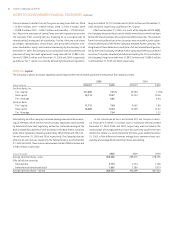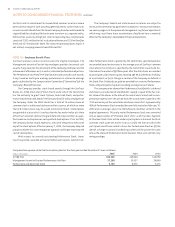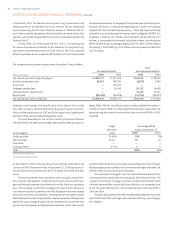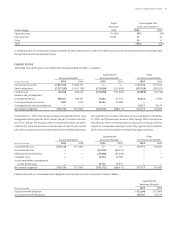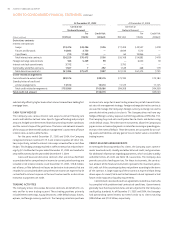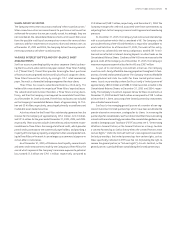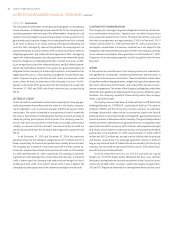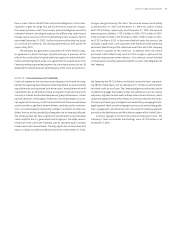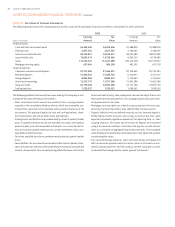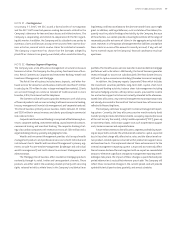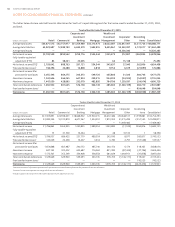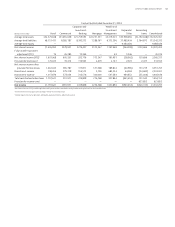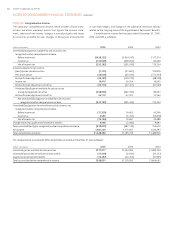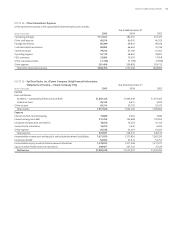SunTrust 2005 Annual Report Download - page 96
Download and view the complete annual report
Please find page 96 of the 2005 SunTrust annual report below. You can navigate through the pages in the report by either clicking on the pages listed below, or by using the keyword search tool below to find specific information within the annual report.
SUNTRUST ANNUAL REPORT94
substantially offset by higher levels of net interest income from holding first
mortgage loans.
CASH FLOW HEDGES
The Company uses various interest rate swaps to convert floating rate
assets and liabilities to fixed rates. Specific types of funding and principal
amounts hedged were determined based on prevailing market conditions
and the current shape of the yield curve. The terms and notional amounts
of the swaps are determined based on management’s assessment of future
interest rates, as well as other factors.
For the years ended December , and , the Company
recognized interest income of . and interest expense of . mil-
lion, respectively, related to interest rate swaps accounted for as cash flow
hedges. This hedging strategy resulted in ineffectiveness that reduced earn-
ings by . million for the year ended December , and resulted in
zero ineffectiveness for the year ended December , .
Gains and losses on derivative contracts that are reclassified from
accumulated other comprehensive income to current period earnings are
included in net interest income. As of December , , . million,
net of taxes, of the deferred net losses on derivative instruments that are
recorded in accumulated other comprehensive income are expected to be
reclassified to interest expense in the next twelve months as derivatives
mature or as payments are made.
TRADING ACTIVITIES
The Company enters into various derivative contracts on behalf of its cli-
ents and for its own trading account. These trading positions primarily
include interest rate swaps, equity derivatives, credit default swaps, futures,
options, and foreign currency contracts. The Company maintains positions
in interest rate swaps for its own trading account as part of its overall inter-
est rate risk management strategy. Foreign exchange derivative contracts
are used to manage the Company’s foreign currency exchange risk and to
provide derivative products to clients. The Company does not have any
hedges of foreign currency exposure within the guidelines of SFAS No. .
The Company buys and sells credit protection to clients and dealers using
credit default swaps. These derivative instruments allow the Company to
pay or receive a stream of payments in return for receiving or providing pro-
tection in the event of default. These derivatives are accounted for as trad-
ing assets and liabilities and any gain or loss in market value is recorded in
trading income.
CREDITRELATED ARRANGEMENTS
In meeting the financing needs of its clients, the Company issues commit-
ments to extend credit, standby and other letters of credit, and guarantees.
For additional information regarding guarantees, which includes standby
and other letters of credit see Note , Guarantees. The Company also
provides securities lending services. For these instruments, the contrac-
tual amount of the financial instrument represents the maximum poten-
tial credit risk if the counterparty does not perform according to the terms
of the contract. A large majority of these contracts expire without being
drawn upon. As a result, total contractual amounts do not represent actual
future credit exposure or liquidity requirements.
Commitments to extend credit are agreements to lend to a client who
has complied with predetermined contractual conditions. Commitments
generally have fixed expiration dates and are subjected to the Company’s
credit policy standards. As of December , and , the Company
had outstanding commitments to extend credit to its clients totaling
. billion and . billion, respectively.
At December , At December ,
Contract or Contract or
Notional Amount Notional Amount
For Credit Risk For Credit Risk
(Dollars in millions) End User Clients Amount End User Clients Amount
Derivatives contracts
Interest rate contracts
Swaps , , , ,
Futures and forwards , , — , , —
Caps/Floors , — , —
Total interest rate contracts , , , ,
Foreign exchange rate contracts , — ,
Interest rate lock commitments , — — , — —
Commodity and other contracts , ,
Total derivatives contracts , , , ,
Credit-related arrangements
Commitments to extend credit , , , ,
Standby letters of credit and
similar arrangements , , , ,
Total credit-related arrangements , , , ,
Total credit risk amount , ,
NOTES TO CONSOLIDATED FINANCIAL STATEMENTS continued


